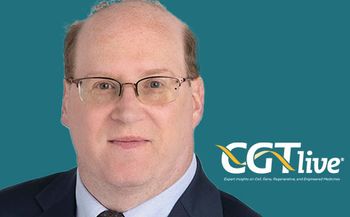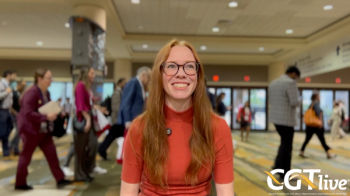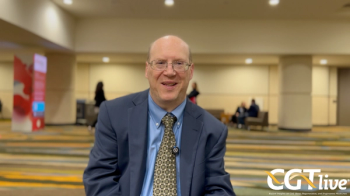
RTX-240 Shows Intriguing Preliminary Efficacy, Safety in Solid Tumors
The modified red blood cell therapy RTX-240 demonstrated promising efficacy and a favorable safety profile in patients with relapsed/refractory solid tumors.
Treatment with RTX-240 demonstrated promising preliminary efficacy and a favorable safety profile in patients with relapsed/refractory solid tumors, according to topline phase 1 data presented by Rubius Therapeutics, the company developing the red blood cell therapy
In the first 16 patients treated in the study, there were 2 partial responses observed with RTX-240, 1 in a patient with anal cancer and another in a patient with uveal melanoma. Moreover, stable disease lasting longer than 12 weeks was observed in 4 additional patients with solid tumors. Treatment remained ongoing in 4 patients and toxicity was relatively mild, with grade 1/2 immune-related adverse events (irAEs) observed in 5 patients and no grade 3/4 irAEs seen in the study. Of interest, liver toxicity was uncommon.
"RTX-240 has a very favorable, emerging safety profile across all the dose levels tested. Only a single event of grade 1 liver toxicity was observed in the trial to date," Christina Coughlin, MD, PhD, chief medical officer at Rubius, said during a presentation of the findings. "We have single-agent activity in the program, with 2 partial responses in 2 very difficult to treat cancers. The pharmacodynamic effects demonstrated the activation and expansion of the two target cells: the NK and T cells."
RTX-240 is manufactured using allogeneic CD34+ hematopoietic precursor cells collected from healthy O-negative donors. These cells are then modified using a lentiviral vector to express 4-1BB and IL15TP, which is a fusion of IL-15 and IL-15 receptor alpha. The cells are then further expanded and differentiated until reticulocytes are produced. These modified cells have the same characteristics as a normal red blood cell and are meant to stimulate an NK and T cell response, according to the company. As normal blood cells, lymphodepletion and post-infusion therapy are not required, and RTX-240 can be administered in the outpatient setting.
In the initial 16 patients, the median age was 55 years and patients had received a median of 3 prior therapies (range, 1-10). Prior to entering the study, 11 of the 16 had received a prior PD-1 or PD-L1 inhibitor and 12 had received prior chemotherapy along with other treatments. There was a washout period before treatment with RTX-240. Overall, there were 5 patients with melanoma, 4 with colorectal or a lower gastrointestinal tract caner, and 7 had a variety of other solid tumors.
Multiple doses of RTX-240 were explored in the study, including 18 cells every 4 weeks (Q4W), 19 every 6 weeks, 39 Q4W, 110 Q4W, and 310 Q4W. Most doses were given intravenously (IV) alone except 1 cohort explore 110 Q4W dose, which was given by IV and intratumorally. Dose-limiting toxicity was not observed at any of these doses and the study continues to seek a recommended phase 2 dose.
At the time of the analysis, response by RECIST v1.1 criteria was available for 14 patients, with a best response rate of 14.3% (n = 2). Both responses were in patients who had progressed on prior checkpoint inhibition. In addition to those with stable disease and responses, 3 patients had progressive disease as their best response.
The first responding patient had metastatic anal cancer and was treated in the third-line setting at 18 Q4W. At the cutoff, the duration of response was greater than 4 months and the tumor had shrank by 54%. The second patient had metastatic uveal melanoma and received RTX-240 at 110 Q4W in the second-line setting. This patient experienced complete resolution of the target lesion and also resolution of 14 of 15 hepatic non-target lesions at week 16.
Responses and stable disease were observed across tumor types, with stable disease seen in patients with non-small cell lung cancer, soft tissue sarcoma, pancreatic cancer, and prostate cancer. Doses in these patients ranged from 110 to 310 cells Q4W.
The most common treatment-related AEs (TRAEs) were chills (n = 3), decreased appetite (n = 3), arthralgia (n = 3), and nausea (n = 3). Other TRAEs included fatigue, fever, myalgia, dysgeusia, and hyperhidrosis (n = 2 each). There were 2 cases of grade 2 fatigue. Grade 2 irAEs included pneumonitis, adrenal insufficiency, and hypothyroidism (n = 1 each) and grade 1 irAEs included arthralgia (n = 3), myalgia (n = 2), AST elevation (n = 1), and ALT elevation (n = 1).
"We are seeing some signs of a dose response, with patients treated with higher doses having the grade 2 AEs," Coughlin said. "The liver enzyme increase was seen at the 110 every 4 weeks dose. It was transient and did not require management."
There was early evidence in 3 of 5 patients with repeat biopsies of both NK and T cell trafficking to tumor. Moreover, in 3 of 4 patients, PD-L1 expression increased post–RTX-240 along with an increased ratio of M1/M2 macrophages, supporting plans for a combination of the red blood cell therapy with a PD-1 inhibitor.
In a case study from a patient with metastatic mesothelioma, there was a 10-fold increase in the percentage of NK cells trafficked to the tumor. Moreover, there was also more than a 4-fold increase in CD8+ T cells. Together, these findings show an improved immune-permissive environment, Coughlin noted. In another case study of AML, there was an 8-fold increase in NK cells and a substantial increase in Granzyme B+ NK and CD8+ T cells.
"We have really compelling, albeit early, target cell trafficking data in solid tumors and our first patient with AML [acute myelogenous leukemia]," Coughlin said. "All of this has been observed even though enrollment still continues in this phase 1 and we're still optimizing the dose and the schedule in this trial. Despite that, RTX-240 is doing exactly what we designed it to do."
Rubius will present findings from the phase 1/2 study at the American Association of Cancer Research Virtual Annual Meeting. The data will be presented during a phase 1 clinical trials session during the meeting, which is being held April 10 to 15, 2021.
“Given the encouraging initial safety and preliminary efficacy data for RTX-240, we plan to initiate a phase 2 expansion cohort in the first quarter of 2022, and a new phase 1 arm of the ongoing RTX-240 clinical trial to evaluate RTX-240 in combination with anti-PD-1 therapy in patients with advanced solid tumors during the second half of 2021,” Pablo J. Cagnoni, MD, president and chief executive officer of Rubius,
RTX-240 has thus far been explored as a single-agent. As a next step, a dose escalation portion of the study will be opened to explore RTX-240 with a PD-1 inhibitor in relapsed/refractory solid tumors. Additionally, in the phase 2 portion of the study, addition tumor-specific cohorts are planned. Altogether, the trial plans to enroll 216 participants (NCT04372706).
Newsletter
Stay at the forefront of cutting-edge science with CGT—your direct line to expert insights, breakthrough data, and real-time coverage of the latest advancements in cell and gene therapy.
















































